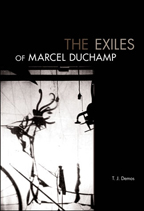 |
T.J. Demos. The Exiles of Marcel Duchamp. Cambridge, Massachusetts, London, England: The MIT Press, 2007.
Through the prism of ‘exile,’ T. J. Demos makes a convincing set of links between Duchamp’s self exile and the exilic metaphors in his work. For example, Duchamp’s La boîte-en-valise, 1935-41, is interpreted by Demos as a portable museum created through the necessity of exile from France during WWII. This portable photographic archive of Duchamp’s own work offers both a counter to the ‘precarious subjectivity’ of the period, while simultaneously being a sign of dispersed experience. Comparing Duchamp’s exhibition designs with the work of André Malraux, Walter Benjamin, El Lissitzky, Kurt Schwitters, and Frederick Kiesler, the author traces notions of displacement and nomadism in Duchamp. Demos situates these arguments within a larger frame that advances Duchamp’s work as an allegory for “a relationality that resisted the essentialism of identity,”and, as such, an important precursor for contemporary debates on these subjects.
|